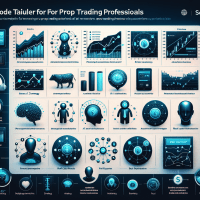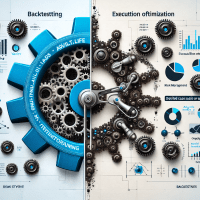Solvent.Life vs Vantir: AI Strategy vs Feedback Models in Prop Trading
In the ever-evolving world of prop trading, advanced backtesting methods and AI-driven strategies are redefining how traders optimize performance and manage risk. Prop firms increasingly rely on automated backtesting platforms to simulate market scenarios, refine algorithms, and gain competitive edges. In this article, we dive deep into a comparison of Solvent.Life’s AI strategy with Vantir’s AI feedback models, exploring actionable insights and real-world case studies to empower both firm-level decision makers and individual traders.
Understanding AI Strategy vs. AI Feedback Models in Prop Trading
Prop trading relies heavily on quantitative techniques and advanced analytics. Two modern approaches gaining traction are AI strategy models and AI feedback models. Here’s what differentiates them:
AI Strategy Models
AI strategy models, like those implemented by Solvent.Life, involve the creation and testing of trading algorithms using machine learning techniques. They focus on generating signals, optimizing parameters, and automating execution in simulated market environments. Often, these models incorporate:
- Advanced statistical methods
- Historical data integration
- Automated parameter optimization
- Stress testing and scenario analysis
AI Feedback Models
In contrast, AI feedback models, exemplified by Vantir, analyze active trading performance. They provide real-time feedback through adaptive algorithms that adjust trading strategies based on market conditions and performance metrics. Key benefits include:
- Continuous performance monitoring
- Dynamic risk management
- Integration with live trading platforms
- Feedback loops for iterative strategy improvement
Comparing Solvent.Life’s AI Strategy with Vantir’s AI Feedback Models
When it comes to aligning with the demands of prop trading, both Solvent.Life and Vantir offer unique advantages. Prop firms need to address platform scalability, team collaboration, and adherence to strict compliance regimes such as MiFID II or ESMA guidelines. Let’s delve into how these platforms measure up:
Backtesting Capabilities and Automation
Solvent.Life employs event-driven backtesting frameworks that optimize complex trading algorithms. Its strengths include:
- Automated Parameter Optimization: The system automatically adjusts parameters to maximize the Sharpe ratio while controlling for overfitting.
- Detailed Reporting: Generates comprehensive reports that include metrics such as maximum drawdown, profit factor, and risk-adjusted returns.
- Historical Data: Access to deep, tick-level historical data across asset classes, ensuring realistic simulations.
Vantir, by contrast, relies on a hybrid approach combining automated backtesting with real-time feedback loops. Key features of their solution include:
- Real-Time Data Integration: Seamlessly integrates live data feeds to adjust feedback models during active trading scenarios.
- Scenario Stress Testing: Provides extensive scenario analyses to evaluate performance under extreme market conditions.
- Feedback Loop Automation: Continuously refines algorithms by analyzing performance metrics in real time.
Tool Integration and Industry Use Cases
Both solutions offer robust integration with popular backtesting and trading platforms. For instance, several prop firms leverage tools like TradingView, MetaTrader 5, and NinjaTrader to execute their strategies. Below is a comparative overview of how these tools support advanced backtesting:
| Tool | Backtesting Features | Data Quality & Depth | Integration Capabilities | Pricing & Use Cases |
|---|---|---|---|---|
| TradingView | Vectorized backtesting, customizable scripts | Strong historical depth, multiple asset classes | Broker integration, API access | Affordable, ideal for retail and prop collaboration |
| MetaTrader 5 | Event-driven backtesting, commission/slippage adjustments | Reliable data feeds, in-depth historical data | Automated trading, script integration | Free demo and competitive pricing tiers |
| NinjaTrader | Robust strategy optimization, scenario analysis | High-quality tick data, comprehensive asset coverage | API access, broker integration | Suited for professional prop setups |
Advanced Backtesting Concepts and Best Practices
Successful prop trading strategies depend on robust backtesting practices. Here are several advanced concepts every prop trader should master:
Identifying and Mitigating Common Backtesting Pitfalls
Overfitting, survivorship bias, look-ahead bias, and data snooping are common issues that can distort backtesting results. Best practices include:
- Out-of-Sample Testing: Always reserve a portion of data to validate strategy performance in unseen market conditions.
- Walk-Forward Optimization: Use iterative testing phases to ensure that parameters remain optimal across different market cycles.
- Handling Commissions and Slippage: Incorporate realistic trading costs to avoid inflated performance metrics.
Integrating Backtesting with Forward Testing
Prop firms are blending backtesting with paper trading and live execution to bridge the gap between historical analysis and real-market performance. A practical workflow includes:
- Run extensive backtesting using tools like Backtrader for automated scenario analysis.
- Implement out-of-sample testing to refine strategy robustness.
- Transition to paper trading environments and monitor key performance indicators including Sharpe ratio improvements and reduced drawdowns.
Data Quality and Sourcing
Reliable backtesting results stem from high-quality data. Considerations include:
- Tick Data vs. Bar Data: Tick data offers granular insights, while bar data provides a broader view suitable for long-term trends.
- Data Cleansing: Adjust for missing data, corporate actions, and market anomalies to simulate realistic scenarios.
- Provider Credibility: Use established data providers to ensure accuracy and reliability.
Real-World Case Studies and Platform Impact
To illustrate these concepts, let’s examine two anonymized case studies from prominent prop trading firms:
Case Study 1: Strategy Optimization at a Leading Prop Firm
A mid-sized prop trading firm aimed to revamp its algorithmic strategy following sustained drawdowns. The team applied Solvent.Life’s AI strategy model, which emphasized automated parameter optimization and rigorous stress testing. Key outcomes included:
- A 15% improvement in the Sharpe ratio after incorporating out-of-sample validations.
- Reduction in maximum drawdown by 10% through accurate commission and slippage modeling.
- Faster iteration times, allowing the team to test multiple strategies simultaneously.
Case Study 2: Real-Time Feedback Enhancements
Another prop firm integrated Vantir’s AI feedback model to monitor live trading performance closely. The system successfully identified lagging indicators and provided actionable feedback, enabling the firm to adjust positions dynamically. Measurable impacts included:
- Improvement in risk management metrics through real-time strategy adjustments.
- Enhanced scenario stress testing that allowed the firm to simulate extreme market events.
- Creation of customized dashboards integrating backtesting results with live trading performance.
Implementing Practical Solutions and Internal Strategies
For traders and risk managers, integrating advanced backtesting outcomes into operational strategies is critical. Here are step-by-step guidelines to bridge theory and live markets:
Step-by-Step Integration Guide
- Data Acquisition: Use trusted data providers to secure reliable historical market data. Ensure the data covers multiple market cycles for robust modeling.
- Automated Backtesting: Configure platforms like MetaTrader 5 or NinjaTrader with realistic market parameters such as commissions and slippage.
- Walk-Forward Analysis: Implement periodic re-optimization of parameters using walk-forward testing to adapt to evolving market dynamics.
- Paper Trading: Transition successful backtested strategies into paper trading for real-time validation before executing live orders.
- Performance Monitoring: Regularly track key metrics including Sharpe ratio, drawdown, and profit factor through dashboard integrations.
Industry Insight: Many successful prop firms recommend pairing backtesting with forward testing. For instance, a risk management checklist used internally might include:
- Tracking of strategy iterations.
- Documenting parameter adjustments.
- Integrating feedback from paper trading results.
- Maintaining a trading journal for continuous strategy refinement.
This rigorous process ensures that even minor improvements accumulate into significant performance boosts over time.
Expert Guidance and Next Steps
As a seasoned prop trading expert, it is advisable to continuously refine strategies by leveraging both automated backtesting and real-time feedback. Consider the following pro tips:
For more advanced insights, explore our internal resources on Advanced Risk Management in Prop Trading and Effective Trading Journal Templates that detail comprehensive checklists and best practices.
Regulatory Considerations and Compliance
Prop trading firms must operate within strict regulatory environments. As of October 2023, adherence to frameworks such as MiFID II, ESMA regulations, and NFA rules is critical. Firms should:
- Regularly audit and update compliance protocols.
- Ensure that backtesting and automated models meet regulatory standards.
- Document strategy development processes comprehensively for regulatory reviews.
Conclusion
Advanced AI models are reshaping the prop trading landscape. Whether you are leveraging an AI strategy model like Solvent.Life or a dynamic feedback system like Vantir, the key lies in integrating robust backtesting, real-time evaluations, and rigorous risk management. By combining technology, data accuracy, and strategic insights, prop firms can achieve improved performance and sustainable growth.
As you refine your trading strategy, remember to continuously test, validate, and adapt. For a detailed Risk Management Checklist and trading journal template, download our comprehensive guide below. Join our upcoming webinar for live demonstrations and further expert discussions on optimizing prop trading strategies.
Next Step: Subscribe to our newsletter for cutting-edge prop trading insights and updates on regulatory changes and advanced backtesting techniques.
Happy Trading!







